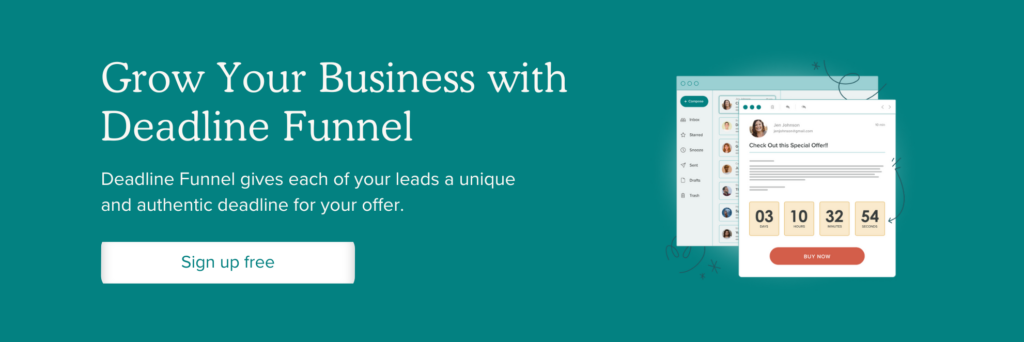

We’ve all felt compelled to make impulse buys or snap-decision purchases before. Sometimes, we immediately question our choices. Other times, it turns out to be an invaluable purchase. Either way, urgency messaging is at work, and it works.
Urgency messaging is a concept that thrives on the psychology of prioritizing necessary decisions above other decisions, even if important, that can be deferred to a later time. It’s a deeply rooted trigger in people’s brains, closely related to scarcity, human loss, aversion, and the now commonly known concept of FOMO or fear of missing out.
Generally, urgency messaging is a type of sales and marketing strategy that makes consumers automatically evaluate whether they want to let a limited-time opportunity get away. Let’s dive into how it works and how you can make it work for your business.
How Urgency Messaging Works
Human anxiety has a way of compelling people to make decisions based on time limits and their relative pleasure or displeasure. Let’s use Valentine’s Day as an example.
The so-called Day of Love is in a few days, and you want to buy candies, chocolates, flowers, or other gifts to show appreciation for your partner or friends. But you’re unsure when to place an order or which e-commerce store to buy it from.
While browsing websites, you encounter a sales promotion for a bundle of gifts that you deem suitable for the recipient. And when you scroll further down, it says, “Order your Valentine’s Day gift now for on-time delivery.” And you fall — Hook. Line. And sinker.
You’re now at peace because you have secured gifts you know will be delivered before Valentine’s Day. But the pressure you felt throughout the quick sales process? That’s exactly how urgency comes into play in marketing.
Why Marketers Value Urgency and Scarcity
Urgency and scarcity don’t necessarily have a negative connotation when used in sales and marketing — not when they are correctly used, that is. They increase engagement because potential customers naturally get curious. They increase conversions and online sales, too, because people are convinced it’s something they need or that they’re getting at a great deal — especially when these offers are said to be limited.
To sum it up, marketers use scarcity and urgency to trigger people’s purchase anxiety and influence them to act promptly.
How Purchase Anxiety Contributes to Urgency Messaging
Most consumers go through a series of thoughts and questions before purchasing something on e-commerce websites. These typically include:
● Am I getting the best value for money with this product?
● Does this product do what it promises?
● Is this better than what competitor brands offer?
● Can I trust this site with my credit card details?
● Are their delivery and return guarantee policies reliable?
These thoughts are commonly associated with “purchasing anxiety,” a concept that can be attributed to why some consumers abandon their online shopping cart in the middle of the buying process. This trend is particularly prevalent when shopping on startups, small businesses, and new e-commerce websites.
However, the moment marketers skillfully insert the concept of urgency or scarcity when promoting products, the need to secure a product – especially limited-time offers – can overpower a person’s natural purchasing anxiety.
The Significance of Urgency in Sales
If you want to boost your sales, you need to achieve two things:
● Establish brand visibility and get consumers to trust your brand and products.
● Make people trust your brand enough to not think twice about buying something.
Then, pair that trust with a sense of urgency. This way, people are more likely to buy your products — no matter how impulsive — because they know they’ll get a good deal.
Consumers feel a sense of urgency when they see that their potential purchase offers something positive, tackling the negative feelings associated with missing out on an experience or losing a great deal. The offer conveys a product’s implied benefits and creates a psychological trigger for a consumer to act quickly and buy what’s in their shopping cart.
On a related note, scarcity makes consumers want to get a product before it runs out. We know scarcity triggers a sense of urgency. Here’s how you can use it to strengthen your marketing strategies:
● Give early-access discounts and time-sensitive price reductions for loyal customers; these often work for product pre-orders and special promos.
● Display a real-time notice when a product is running low.
● Use a cart timer that shows customers how much longer they can reserve a product in their cart before someone else can buy the item.
● Offer same-day or next-day delivery for products sold until a specific time.
● Release special edition products; the low supply results in higher demand.
● Sell seasonal products to help your business secure more sales during specific times of the year. You could release new products every year. Or, you can release high-demand products from previous years to encourage customer retention.
● Add a feature on your e-commerce website that displays the highest-demand products. This makes people wonder whether the popularity would cause the product to sell out, causing them to miss out on getting it.
Effective Examples of Urgency Messaging
When done right, urgency messaging can boost conversion rates and help you establish a sustainable business model. There are various ways to trigger urgency and make consumers more interested in your products. Let’s discuss them below.
Limited Time Offers
People are more inclined to want something when they know it won’t be there forever. It’s in our nature. It’s also why limited-time offers are a successful marketing tactic.
Take, for example, the seasonal beverage flavors sold at cafes — pumpkin spice-themed drinks during autumn or Christmas-themed drinks during winter. These flavors usually change every year, building anticipation around the beverages and making them seem more special.
Another example would be limited-time discounts and promos when a new store opens or when you introduce a new product. People know there’s a time limit to these offers, so they are more likely to grab the opportunity.
Limited Supply
Similar to limited-time offers, people are more likely to go down the sales funnel and complete a purchase if they know a product is only available in limited supply.
One example would be limited prints of an artist’s work. These often come with a certificate of authenticity proving they are official artwork prints. Since they are limited, the prints command a higher value and will interest the audience more.
Another example would be sneakers or clothes sold in limited quantities. Consumers don’t just like the design of these items; they are extra appealing because not everyone will get their hands on a pair of sneakers or a specific dress. These items could also resell at a higher price over time, adding to their value appeal.
Last Chance Alerts
Alerting customers that it’s their last chance to purchase a product, either because it’s a limited-time offer or low in stock and wouldn’t be available again for some time, is an effective way to increase urgency. You could install software on your e-commerce website that could automatically notify visitors that it’s their last time to get an item.
However, you have to use these alerts in moderation. If all items have last-chance alerts, or if you regularly restock your inventory, customers will learn to ignore them.
Alternatively, you can utilize your official social media pages or profiles to let your followers know about these last-chance deals.
Countdown Timer
If there’s one way to get people to take action, it’s through the use of a countdown timer. Whether it’s to show how long the item will be available or for how long it will be at a discounted price, a countdown timer adds an unmatched sense of urgency because people will think they’re running out of time and an opportunity will be lost forever.
Be wise with countdown timers. Don’t use them for every other promotion. It’s best to use a timer for limited edition items and with last-chance alerts to amplify the need to act quickly. Use it too often, and the sense of urgency will decrease.
Implied Urgency
Implied urgency involves using words like “today” or “now” rather than directly triggering a sense of urgency in the readers. It’s a subtle nudge that suggests the need to take action. The best part about this is it can be used across all content-related strategies, from product pages to website CTA banners to social media marketing.

How to Create Urgency in Your Marketing
Black Friday Sale is another example that maximizes urgency and scarcity messaging as a psychological trigger to make people check out what’s resting in their online carts. It’s the quintessential example of an urgent situation that pushes people to act fast.
But how do you write urgency in text and other forms of marketing?
If used correctly and ethically, urgency can be extremely valuable in your efforts to boost sales and conversions. Here are some best practices you can combine to build an effective marketing strategy centered on creating urgency and scarcity.
Avoid Using Fake Urgency
Creating urgency can be a massive help to your marketing strategy, but be careful not to abuse it. It will not have the desired effect if you put items on sale all year round. It would imply that everything on your website is a bargain. People might also take it as a manipulative tactic.
Convey the Urgency with the Right Vocabulary
Build scarcity and give customers the extra impetus they may need to purchase a product by using the correct vocabulary in your promotional offers. Consumers can quickly tell fake bargains and real deals apart. So, word your scarcity messaging in a way that lets them know at first glance that they’re getting the real deal.
Creating Urgency with CTAs
Your call-to-actions are just as important, if not more, than your actual copy when you’re trying to build opportunities for a higher conversion rate. So, inject powerful CTAs that create urgency in your content and website banners.
Email Marketing
Urgent situations push people to make decisions quickly. So, build urgency in your email marketing strategy by starting with a powerful email subject. Keep your copy short and your CTA strong, offer a scarce solution and set a deadline for the solution.
Real Numbers and Social Proof
Finally, to stay continually connected with your target audience and convert them into customers, you have to give them a reason to buy from you. And few things provide higher value than real numbers from actual sales and social proof from customers.
Drive Sales with Marketing Strategies Proven to Work
Urgency messaging amplifies your business strategy by letting your target audience know that a specific item or offer is only available for a limited period. Get in touch with us to learn more about how it can help your business!




